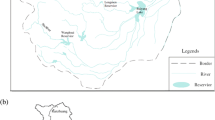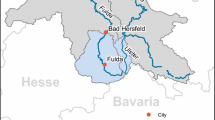Abstract
Increasing global trends in time series of annual maximum daily streamflow (AMX) raise the concern that the safety of dams and other sensitive structures is compromised. There is no defined methodology to estimate the design flood (DF) under non-stationarity; thus, the objective of this work is to evaluate the behavior of the hydrological risk of Brazilian dams due to the non-stationary nature of the AMX time series and the implications of the non-stationary nature of the AMX time series in the design of new dams. For this, the hydrological risk of 108 AMX time series was evaluated, comparing the time intervals between 1954–1984 and 1954–2014. A case study was also executed, where the DF was estimated in a non-stationary time series. The generalized distribution of extreme values (GEV) was applied in the time series analyses. The results indicate that the hydrological risk of Brazilian dams increased, and safety may have been reduced. Regarding the ranking of models, the use of physical covariates in the estimate of the DF makes the estimates more reliable. Finally, although significant trends are good indicators, they alone do not guarantee a reduction or increase in risk. It was also observed that using non-stationary models is less important than updating the estimates with newly observed data.




Similar content being viewed by others
Materials Availability
Data are available from the corresponding author.
Code Availability
Not applicable.
References
ANA (2009) RESOLUÇÃO No271, DE 27 DE ABRIL DE 2009. Agência Nacional de Águas, https://arquivos.ana.gov.br/resolucoes/2009/271-2009.pdf. Accessed Nov 15 2020
Bartiko D, Oliveira DY, Bonumá NB, Chaffe PLB (2019) Spatial and seasonal patterns of flood change across brazil. Hydrol Sci J 64(9):1071–1079. https://doi.org/10.1080/02626667.2019.1619081
Carney MC (2016) Bias correction to gev shape parameters used to predict precipitation extremes. Journal of Hydrologic Engineering 21(10):04016035. https://doi.org/10.1061/(ASCE)HE.1943-5584.0001416
Cheng L, AghaKouchak A, Gilleland E, Katz RW (2014) Non-stationary extreme value analysis in a changing climate. Climatic Change 127 (2):353–369. https://doi.org/10.1007/s10584-014-1254-5
Coles S, Bawa J, Trenner L, Dorazio P (2001) An introduction to statistical modeling of extreme values, vol 208. Springer, Berlin
Cooley D (2013) Return periods and return levels under climate change. In: Extremes in a changing climate, pp 97–114
De Paola F, Giugni M, Pugliese F, Annis A, Nardi F (2018) Gev parameter estimation and stationary vs. non-stationary analysis of extreme rainfall in african test cities. Hydrology 5(2):28. https://doi.org/10.3390/hydrology5020028
Felder G, Paquet E, Penot D, Zischg A, Weingartner R (2019) Consistency of extreme flood estimation approaches. Journal of Hydrologic Engineering 24(7):04019018. https://doi.org/10.1061/(ASCE)HE.1943-5584.0001797
François B, Schlef K, Wi S, Brown C (2019) Design considerations for riverine floods in a changing climate–a review. J Hydrol 574:557–573. https://doi.org/10.1016/j.jhydrol.2019.04.068
Franzke CL, Czupryna M (2020) Probabilistic assessment and projections of us weather and climate risks and economic damages. Clim Chang 158 (3):503–515. https://doi.org/10.1007/s10584-019-02558-8
Gilleland E, Katz RW, et al. (2016) Extremes 2.0: an extreme value analysis package in r. Journal of Statistical Software 72(8):1–39. https://doi.org/10.18637/jss.v072.i08
Grajales-Cardona D, Carvajal-Serna LF (2019) Nonstationary intesity-duration-frequency curves for medellin river basin. Dyna 86 (208):321–328. https://doi.org/10.15446/dyna.v86n208.69300
Guo Y, Fang G, Xu YP, Tian X, Xie J (2020) Identifying how future climate and land use/cover changes impact streamflow in Xinanjiang Basin, East China. Science of The Total Environment 710:136275. https://doi.org/10.1016/j.scitotenv.2019.136275
Hamdi Y, Duluc CM, Rebour V (2018) Temperature extremes: estimation of non-stationary return levels and associated uncertainties. Atmosphere 9 (4):129. https://doi.org/10.3390/atmos9040129
Hu Y, Liang Z, Singh VP, Zhang X, Wang J, Li B, Wang H (2018) Concept of equivalent reliability for estimating the design flood under non-stationary conditions. Water Resources Management 32(3):997–1011. https://doi.org/10.1007/s11269-017-1851-y
Iannelli CM, Rigoletto IDP (2020) Brumadinho–riscos, impactos e perspectivas futuras. In: Liguori C, Levy DR (eds) Brumadinho: da Ciência à Realidade, Liberars, São Paulo, Brazil, pp 27–52
IBGE (2020) Censo demográfico: 1960/1970/1980/1990/2000/2010. Instituto Brasileiro de Geografia e Estatistica. https://biblioteca.ibge.gov.br/. Accessed Nov 14 2020
ICOLD (2019) Dams’ safety is at the very origin of the foundation of ICOLD. International Commission on Large Dams. https://www.icold-cigb.org/GB/dams/dams_safety.asp. Accessed Sep 03 2019
Kim SU, Lee CE (2021) Incorporation of cost-benefit analysis considering epistemic uncertainty for calculating the optimal design flood. Water Resour Manag 35:757–774. https://doi.org/10.1007/s11269-021-02764-z
Kudryavtseva N, Soomere T, Männikus R (2020) Non-stationary analysis of water level extremes in latvian waters, baltic sea, during 1961–2018. Natural Hazards and Earth System Sciences Discussions, pp 1–23. https://doi.org/10.5194/nhess-2020-100
Li J, Lei Y, Tan S, Bell CD, Engel BA, Wang Y (2018) Nonstationary flood frequency analysis for annual flood peak and volume series in both univariate and bivariate domain. Water Resources Management 32:4239–4252. https://doi.org/10.1007/s11269-018-2041-2
Liu S, Huang S, Xie Y, Wang H, Leng G, Huang Q, Wei X, Wang L (2019) Identification of the non-stationarity of floods: changing patterns, causes, and implications. Water Resour Manag 33:939–953. https://doi.org/10.1007/s11269-018-2150-y
Mackay E, Jonathan P (2020) Assessment of return value estimates from stationary and non-stationary extreme value models. Ocean Eng 207:107406. https://doi.org/10.1016/j.oceaneng.2020.107406
Mediero A, Jiménez-Álvarez L, Garrote L (2010) Design flood hydrographs from the relationship between flood peak and volume. Hydrol Earth Syst Sci 14:2495–2505
Menescal RDA (2005) A segurança de Barragens e a gestão de Recursos hídricos no Brasil. Ministério da Integração Nacional. https://bibliotecadigital.seplan.planejamento.gov.br/handle/iditem/202. Accessed Nov 13 2020
Mondal A, Mujumdar P (2017) Hydrologic extremes under climate change: non-stationarity and uncertainty. In: Sustainable water resources planning and management under climate change, Springer, pp 39–60. https://doi.org/10.1007/978-981-10-2051-3_2
Moreira JGDV, Naghettini M, Eleutério JC (2016) Frequência e risco sob não-estacionariedade em registros pluviométricos da bacia do alto rio tarauacá, acre. RBRH 21(1):232–241. https://doi.org/10.21168/rbrh.v21n1.p232-241
Nashwan MS, Ismail T, Ahmed K (2019) Non-stationary analysis of extreme rainfall in peninsular malaysia. Journal of Sustainability Science and Management 14(3):2672–7226
Pohlert T (2020) Probability plot correlation coefficient test. The R Foundation. https://cran.r-project.org/web/packages/ppcc/ppcc.pdf. Accessed Nov 15 2020
Razmi A, Golian S, Zahmatkesh Z (2017) Non-stationary frequency analysis of extreme water level: application of annual maximum series and peak-over threshold approaches. Water Resources Management 31(7):2065–2083. https://doi.org/10.1007/s11269-017-1619-4
Salas JD, Obeysekera J (2014) Revisiting the concepts of return period and risk for nonstationary hydrologic extreme events. Journal of Hydrologic Engineering 19(3):554–568. https://doi.org/10.1061/(ASCE)HE.1943-5584.0000820
Serinaldi F, Kilsby CG (2015) Stationarity is undead: uncertainty dominates the distribution of extremes. Adv Water Resour 77:17–36. https://doi.org/10.1016/j.advwatres.2014.12.013
SNIRH (2019) HidroWeb. Sistema Nacional de Informações sobre Recursos Hidricos. http://www.snirh.gov.br
SNISB (2019) O Relatório de Segurança de Barragens 2019. Sistema Nacional de Informações sobre Segurança de Barragens, http://www.snisb.gov.br/portal/snisb/relatorio-anual-de-seguranca-de-barragem/2019
Šraj M, Bezak N (2020) Comparison of time trend-and precipitation-informed models for assessing design discharges in variable climate. J Hydrol 589:125374. https://doi.org/10.1016/j.jhydrol.2020.125374
Šraj M, Parajka J, Blöschl G (2016) The influence of non-stationarity in extreme hydrological events on flood frequency estimation. Journal of Hydrology and Hydromechanics 64(4):426–437. https://doi.org/10.1515/johh-2016-0032
Wilcox C, Vischel T, Panthou G, Bodian A, Blanchet J, Descroix L, Quantin G, Cassé C, Tanimoun B, Kone S (2018) Trends in hydrological extremes in the senegal and niger rivers. Journal of Hydrology 566:531–545, . https://doi.org/10.1016/j.jhydrol.2018.07.063
Yan L, Li L, Yan P, He H, Li J, Lu D (2019) Nonstationary flood hazard analysis in response to climate change and population growth. Water 11 (9):1811. https://doi.org/10.3390/w11091811
Acknowledgements
We thank the reviewers for their work; their suggestions were important to improving this study. This research was supported by the UNIEDU/FUMDES, FAPESC, and CNPq. We thank ANA for providing data and special thanks to the authors, Mojca Šraj and José Genivaldo do Vale Moreira, for accessing the data of their studies.
Funding
Monthly student grant by PROGRAMA UNIEDU/FUMDES PÓS-GRADUAÇÃO (1423/SED/2019).
Financial support by FAPESC (grant 2016TR2525).
The productivity scholarship by CNPq (process 440938/2017-1).
Author information
Authors and Affiliations
Contributions
Theoretical-conceptual foundation and problematization: Adilson, Daniel, Leandro
Data research and statistical analysis: Leandro, Daniel, Adilson
Elaboration of figures and tables: Leandro
Elaboration and writing of the text and selection of references: Leandro, Adilson, Daniel.
Corresponding author
Additional information
Publisher’s Note
Springer Nature remains neutral with regard to jurisdictional claims in published maps and institutional affiliations.
Rights and permissions
About this article
Cite this article
Isensee, L.J., Pinheiro, A. & Detzel, D.H.M. Dam Hydrological Risk and the Design Flood Under Non-stationary Conditions. Water Resour Manage 35, 1499–1512 (2021). https://doi.org/10.1007/s11269-021-02798-3
Received:
Accepted:
Published:
Issue Date:
DOI: https://doi.org/10.1007/s11269-021-02798-3




